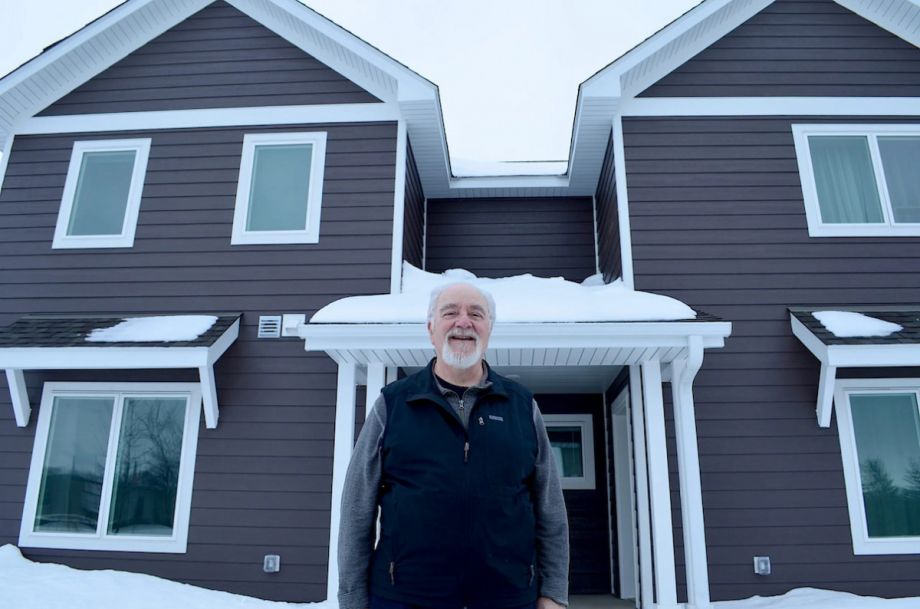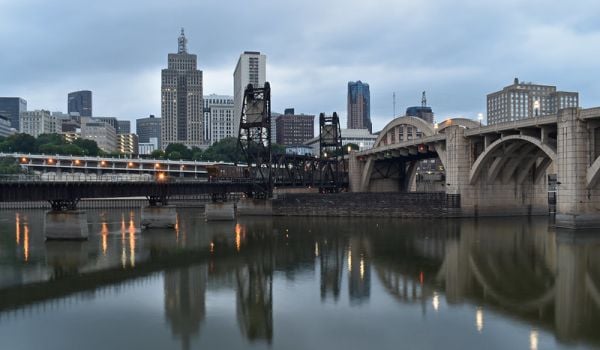This story was originally published by Energy News Network.
Sustainability has long been promoted as a luxury amenity, with energy efficiency features marketed as a selling point for upscale residential and retail development — along with elegance, beauty and tranquility, and amenities such as private rooftop gardens.
For example, just south of St. Petersburg, Florida, Hunters Point Pearl Homes & Marina features high-end single-family homes, all solar-powered and LEED certified, designed in collaboration with the Florida Solar Energy Center at the University of Central Florida.
Each home design also carries a seven-figure asking price.
Meanwhile, Hillcrest Village, an affordable housing development in Northfield, Minnesota, is virtually indistinguishable from market-rate housing. Yet it touts an 84-kilowatt solar array and net-zero energy usage through all-electric heating, cooling and appliances, along with other energy efficiency features — while maintaining rents far below the median for the area.
The Northfield development challenges the notion that sustainability and affordability are mutually exclusive — if the definition of each is expanded to accommodate the greater public good of making the necessary upfront investment. The $5.5 million project was funded by both private investment and public funds. It serves as an example of a growing recognition on both the municipal and federal levels that subsidies are both necessary and a legitimate means of squaring the numbers for affordable and sustainable housing.
Those benefits include long-term cost savings, because better-built buildings will last longer and require fewer repairs, as well as a healthier environment for occupants and aesthetics that integrate better into existing neighborhoods. And lower energy costs, including lower utility bills resulting from energy-efficient HVAC and appliances, help renters on tight budgets stretch their dollars further.
Stable, high-quality affordable housing also provides a benefit to the surrounding community, according to Brian Nowak, principal at Sweetgrass Design Studio, who developed the Northfield project on behalf of Community Action Center.
“It’s an investment over time, to build resilient, energy-efficient housing,” he said. “That should be everyone’s goal. And if we don’t, for example, it affects our school system. It affects the employers at Northfield having people that are readily available to come in and fill the jobs that are needed.”
Rethinking affordability
The notion that affordable housing requires shoddy construction and materials — never mind omitting any consideration of energy efficiency — has increasingly come under challenge by practitioners like Ben Bentley. Bentley is the executive director and CEO of Knoxville’s Community Development Corporation in Tennessee, which oversees a number of affordable housing properties.
“I think housing needs to be built to a high standard regardless of whether it’s affordable or market rate,” Bentley said. “To me, it’s really important that it’s rather indistinguishable.”
Bentley said that poorly built public housing in the past “created sort of a stigmatization of certain areas.”
“As we’re building new things moving forward, and as we’re partnering on innovative technologies like that with [the Department of Energy], we’re really considering how we build to a standard where someone that drives by this neighborhood is not going to say, ‘Well, that’s where low-income families live,’” Bentley said. “They’re going to think, ‘Wow, that’s just a great place to live. That’s a great neighborhood.’ That’s what we’re trying to do.”
Likewise, in Northfield, both sustainability and aesthetic appeal were integral. Making the units as indistinguishable from market-rate housing as possible was an essential consideration, according to Nowak.
“The houses on the outside are pretty traditional, or they’re traditional looking. And that was the intent,” Nowak said. “They have a certain percentage [of] workforce housing; another percentage is transitional in emergency housing. And they didn’t want the people that were in transition in their lives or in crisis to feel like they were walking into a home that was a science experiment or an art project. … They wanted them to feel like homes that these people would go anywhere in Northfield and live in. That was a primary concern.”
Making the numbers work
Especially when using public funds, there is always pressure to do things as cheaply as possible, which often necessitates difficult tradeoffs with architectural design and building construction. But these tradeoffs do not necessarily or inevitably equate with poor workmanship or bland design. Rather, intentionality in making choices and compromises is key, said Danielle Tillman, managing principal at bKL Architecture in Chicago.
“Every project has budget and cost constraints,” Tillman said. “I think there can be an education on materials and figuring out the details that can potentially make less expensive materials still feel nicer than whatever. I think there can be opportunities to create good design, large or small.”
Incorporating sustainability and energy-saving metrics can actually ultimately translate into increased affordability, and by extension, play a significant role in allowing developers to generate reasonable returns on their investments. Likewise, taking a long-term approach to ownership is necessary in squaring the numbers.
That’s the calculation employed for making the upfront sustainability investments needed to achieve net-zero energy usage for the Northfield development — while maintaining low rents, around $800 a month, for residents, Nowak said.
“That’s a significant long-term benefit of a project like this. And that is not just your monthly rents on the building; it’s the cost of the utilities as well. When those utilities include your electricity and your heating and cooling that’s a really big deal,” Nowak said.
Additionally, cross-referencing construction costs with energy efficiency goals generates savings that can significantly reduce or offset higher upfront expenses, according to AJ Patton, founder and CEO of 548 Enterprises in Chicago.
“People just assume that sustainable is more expensive without even doing the research or talking to the construction community,” Patton told the Energy News Network in January. “It may just be different, not more expensive. For example, we have buildings that we’re installing solar on that will create $40,000 a year in savings [in electricity costs]. If I could save you $40,000 a year, I have your attention, right?
“And then you extrapolate that out over several years, you’re going to save hundreds of thousands of dollars by that commitment of renewable energy. If you paired that with efficient HVAC and lighting systems, high-efficiency windows — now we’re getting closer and closer to almost six figures a year in energy savings — real savings, real dollars. If everything else kind of historically pays for itself somewhere between six and six and a half years, if I plan on holding this property for any significant period of time, I’m in the black real quickly.”
Nonetheless, upfront costs of sustainability and energy efficiency present a significant obstacle, even for designers and developers with a sincere intention and desire to incorporate them.
Subsidies and other financial support, including DOE and IRS tax credits, provide a needed incentive for developers, both public and private, to construct, upgrade and properly maintain affordable housing. For example, subsidies and tax credits were applied to incorporate new appliances, energy-efficient LED lighting and other improvements in Western Heights, Knoxville’s Community Development Corporation’s largest affordable housing development, originally constructed in 1939, Bentley said.
“If I have a property that’s producing $2 million in revenue and I have $600,000 in net operating income, rather than continuing to let my asset depreciate and not reinvest in it, which historically has been what has been forced to happen because of some of the rules and regulations in public housing, I can now [incorporate needed maintenance and upgrades] through tax credits,” Bentley said.
Unintended consequences
Another major challenge is ensuring existing residents aren’t displaced by the gentrification that often follows when the building stock is renovated in a disinvested community. Intentionality in minimizing displacement while integrating economic resources and other amenities in disinvested communities is a necessity, Bentley said.
“Chicago and some of the big cities tend to be a little further ahead of it, but mixed-income housing is important for a number of reasons,” Bentley said. “I think it’s important to tear down some of those historic patterns of segregation by race and by income. It’s important that we are investing in neighborhoods that have a wide range of incomes.
“And let me be very clear when we do that, we have to protect first and foremost the people, whether they’re low, moderate income or whoever it is, the folks that already live in the neighborhood. But then we have to look beyond that and say, how do we bring in new amenities and new people and get a vitality and a diversity of incomes in the same place?”
Indeed, the Chicago Housing Authority’s Plan for Transformation has largely entailed replacing outdated public housing projects with economically diverse neighborhoods, consisting of new construction boasting energy-efficiency features, along with making extensive energy-conscious renovations to existing developments that were left standing.
However, to date, the plan has also resulted in a sizable net reduction of available public housing units in both new construction and rehabilitated developments, even as former residents displaced by demolished units languish on waiting lists, and market rate developments are green-lighted on former public housing sites.
This fact, along with the integration of affluent — and often White — market-rate renters and homeowners in newly designated mixed-income developments, has resulted in the displacement of large numbers of Black and Brown public housing residents, creating skepticism and resistance to renovation plans.
This was the case for Andre Brumfield, principal and design director for Gensler in Chicago.
As a young architect working at the time with Chicago architecture firm Skidmore, Owings and Merrill, Brumfield encountered significant skepticism when he signed on to execute the transition of a notorious Chicago Housing Authority project, Stateway Gardens, into a mixed-income community.
The assignment often involved hearing out residents’ grievances as much as discussing the actual design. Pressing issues that had not been addressed by the housing authority or city council members, such as non-working elevators and rampant gang and drug activity, initially dominated the meetings.
The discussions were often challenging for Brumfield, who had never lived in public housing — let alone high-rise subsidized structures.
“Here I am, talking about working with the housing authority, who hasn’t addressed the concerns these families have for decades, about how this plan is going to not only change their lives, but how they can actually have a voice in this process,” Brumfield said. “Convincing them that this change is going to happen and explaining how they can actually be a part of this change is an important conversation to start with.”
However, the content and nature of the discussions shifted over time.
“It went from these meetings where we were talking about the day-to-day issues, which, in some cases, we were already starting to address, to having a conversation about density and dynamism in their neighborhood,” Brumfield said. “They start thinking about their views overlooking the lakefront and White Sox park and can start to feel inspired about the building’s future.
“Eventually, the discussion started to be talking about the future — their future. There was already a community there. How do we keep that sense of community? How do we stay here, and then beyond that, how do we keep that sense of community even though our built environment is changing around us?”
Needed policy changes
Political will and a continued recognition that investment on the front end is a worthwhile use of resources — including municipal, county, state and federal funding — is necessary to address and resolve the return-on-investment dilemma of sustainability in affordable housing development, Bentley said.
“I want to give credit where it’s due. I think HUD has recognized this and the congressional folks have recognized it, through [the rental assistance demonstration] program. … They’ve come a long way over the last 10 years in recognizing the challenge to the existing [public and affordable housing] inventory and trying to make it better,” Bentley said.
Nowak says a holistic approach is needed, along with a willingness to move forward, even with the recognition that the process often presents significant challenges.
Future developers “must take the leap and do it,” Nowak said. “They just have to, first, do a resilient design, and then they have to implement that resilient design, and then figure out how to fund it. So those three parts are a challenge. It’s not a walk in the park.”
Architects and design practitioners also have a practical role in shaping human experience, along with exercising creativity in their work in designing developments — including affordable housing, Tillman said.
“I think that it is lofty to think that architecture can save the world, but it is a social science. It is the built environment and the neighborhood. And your experience as you walk through neighborhoods is important to your day-to-day life, how you experience outside and inside. And what that feels like is important to everyday life,” Tillman said. “Everyone deserves to have a pleasant experience, and design should definitely be considered as development happens throughout neighborhoods and cities.”
This article is part of Backyard, a newsletter exploring scalable solutions to make housing fairer, more affordable and more environmentally sustainable. Subscribe to our weekly Backyard newsletter.

Audrey F. Henderson is a Chicagoland-based freelance writer and researcher specializing in sustainable development in the built environment, culture and arts related to social policy, socially responsible travel, and personal finance. Her work has been featured in Transitions Abroad webzine and Chicago Architect magazine, along with numerous consumer, professional and trade publications worldwide.


















